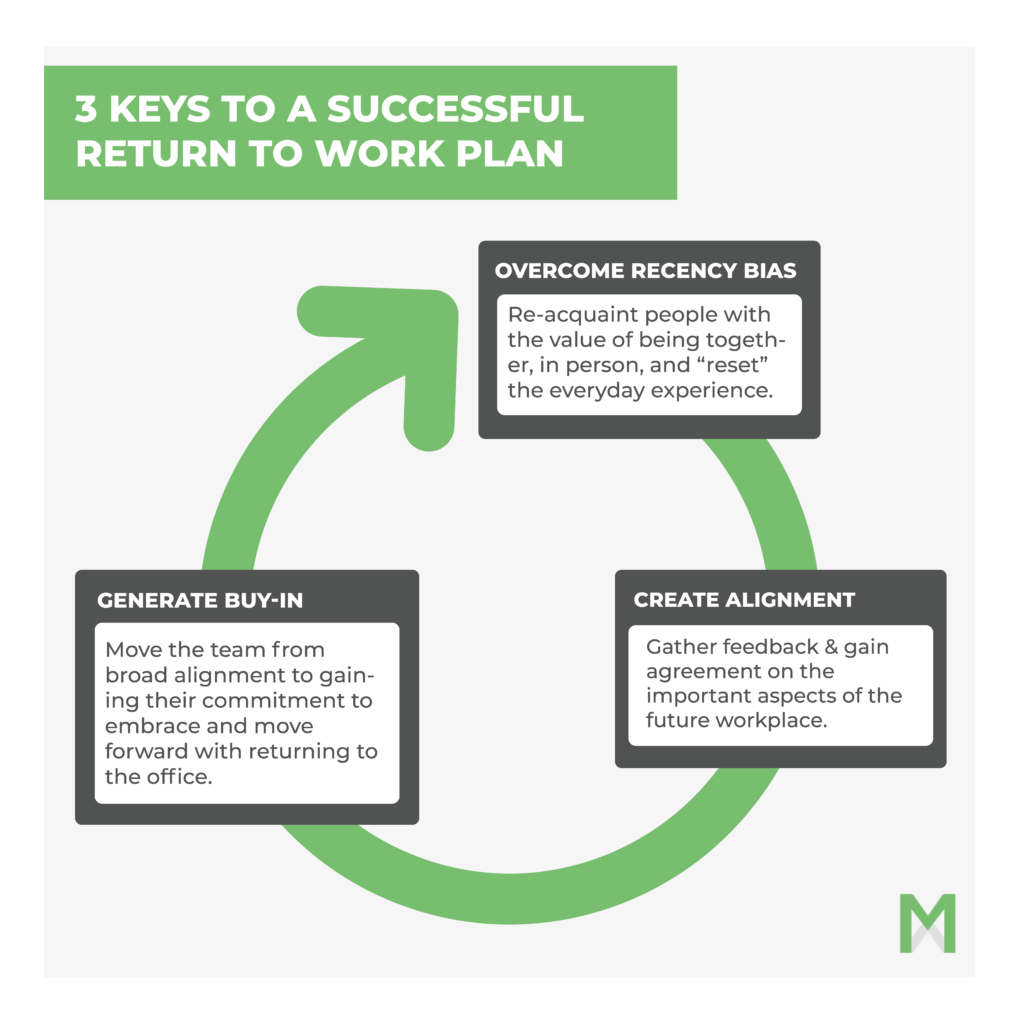How do I get my employees to return to the office? It’s the essential question that anyone tasked with leading the return to office planning has to answer. Getting people excited about returning to the office after spending the last two years working from home is going to be easier said than done. Leaders will need to overcome recency bias and generate enthusiasm for coming back to the workplace by leaning into what people valued about the office – and diminishing what they didn’t.
While there’s no set template to follow, one thing is clear: the pandemic introduced and accelerated a remarkable degree of change, making it unlikely that one can simply revert to how things were done before the pandemic. Approaching the task of developing your company’s return to work plans with an open mind, and expecting some changes, will increase the likelihood of success. You will have a better chance to meet the goals you set for bringing people back to the office while keeping morale and enthusiasm high and avoiding the embarrassing missteps some prominent leaders have made.
The 3 factors that will make or break return to office plans
Creating return to work plans that, well, really work requires an approach that is more expansive than simply setting the policy and telling people about it. Three factors will play an outsize role in your plan’s success, and these are:
- Overcoming recency bias: Recency bias is a cognitive bias (or more specifically, a memory bias) that results in our favoring recent events over historic ones, meaning we assign greater importance to the most recent events we experience. For leaders, this means that employees who have been working from home consistently for the last two years are likely to weigh the perceived benefits of working from home more highly than their pre-pandemic time in the office.
- Creating alignment: Creating alignment on what’s important in the future workplace is a crucial step. Without alignment, you’re more likely to have coercion than agreement, and the former is not a great morale-builder. Creating alignment means more than getting people on the same page: in a literal sense, the word “alignment” implies agreement or alliance. When it comes to developing a return-to-office plan that doesn’t just get people back into the office and instead becomes a catalyst for boosting performance and morale, getting broad agreement on what that plan comprises is central to success.
- Generating buy-in: Creating alignment doesn’t mean that everyone is on board. Getting people to buy into the RTO plan involves moving from broad alignment to gaining your team’s commitment to embrace and move forward with returning to the office.
These three factors are not linear – in fact, it’s more useful to think of them as a continuous cycle, as all three will build on each other, and grow in strength over time.

How to overcome recency bias
Overcoming recency bias takes some effort, as you’re effectively creating new experiences that people enjoy and value, to provide a counterweight against the last two years of remote work.
To overcome recency bias, you need to provide a compelling answer for people to the following question: What do I get from being in the office that I can’t get whilst working from home, and is worth all the time and effort it takes to go into the office?
The answer needs to be more than “Your paycheque.”
To find the compelling answer that will demonstrate the value of being in the office, in person, leaders should gather feedback from their team and use that input to intentionally structure in-office days.
Gathering feedback can easily be achieved with a short employee survey like the On-Demand surveys Engagement Multiplier offers. Invite people to recall and focus upon what worked well about being in the office, with questions such as:
- Thinking back to before the pandemic, what did you enjoy about being in the office?
- What types of meetings or interactions are not as productive when working remotely?
- How do you feel remote work has impacted your career development?
- What types of meetings or tasks are best done in person?
In the spirit of improving the office experience, it’s also useful to tease out the aspects of office life that worked less well for the team.
- Thinking back to before the pandemic, what was the biggest challenge to working in the office with others?
- How did your work schedule change when you were working from home?
- How has working remotely affected the number of hours you work?
One important note: The questions above all focus on the in-office experience, and do not cover topics such as flexible working, employee mental health, work-life balance, or commuting. Gathering your employees’ input on these kinds of topics can provide invaluable insights that will enable you to fine-tune policies and avoid missteps. If your return to work plan will include any of these aspects, asking your team a question or two about their challenges and experiences in those areas will help you craft plans your people value, rather than simply ticking a box.
Once you have your employees’ feedback, you’ll likely find that patterns emerge in their responses, enabling you to quickly identify the aspects of office life and the kinds of meetings, activities, and interactions they value the most. At the same time, you’ll also have a good idea of the aspects of working in the office that detract from the experience.
Using feedback to craft in-office experiences
The question now is what to do with this information and that depends upon your organisation’s approach to future workplace planning. Your objective could be to simply find the happy medium that will appeal to the most employees or to seize this moment to make significant changes, such as embracing a permanently hybrid work schedule. Whatever your objective is, here are some pointers to consider:
Identify activities your team says achieve better outcomes when done in person, such as:
- Highly collaborative activities, such as strategy, planning, and brainstorming meetings,
- Sessions in which new hires and others new in their roles will benefit, such as onboarding, shadowing, and training,
- High-stakes meetings involving project planning or decisions in which detail is important,
- One-on-one meetings.
Similarly, identify the activities the team feel are best suited to remote work, such as:
- Tasks requiring deep focus and few distractions
- Small team meetings that are short and to the point
- Administrative or routine tasks
Getting alignment with great communication
As is the case any time you survey your employees, you’ll build trust and transparency by sharing the results. A communication from leadership that notes the company’s commitment to use employee feedback to inform workplace plans, and says, “Here’s what you told us” creates common ground upon which you can build your plan.
Share the findings, and don’t forget to tell your people how the information they provided will be used. When people can see their input in the resulting planning, they are much more likely to embrace the plans.
Craft the in-office day schedules
Using these insights, create schedules for in-office days that center on the activities that your employees tell you are better in person. Build in time to get your new hires connected to their colleagues. Have leaders clear their calendars and participate fully in the in-office days, and consider including town halls or other sessions for leaders to provide updates on the strategy and progress. Throwing in a pleasant surprise – a catered lunch or treats for a coffee break – can make the experience even more uplifting.
All this said, resist the temptation to overschedule. Leave time for people to reconnect with their peers and schedule the meetings they need. Additionally, keep in mind that one day isn’t enough to overcome recency bias, and consider that part of the challenge is the simple fact that people need to develop new habits. A series of thoughtfully planned days will show the stark difference between being in the office and working from home, and you’ll make important steps toward defeating the effects of recency bias.
If you can do so, run a short survey to gather team feedback about the in-office days. What do they want more of and less of? What did they enjoy most? What surprised them? How did being in the office make them feel? Questions like these will deliver insight that allows you to fine-tune the plans.
Closing the loop & getting employee buy-in
The last step involves sharing the vision for the company’s return to work, and providing a compelling “why” that moves people to embrace the plan.
- Recap what they told you, in terms of the survey findings.
- Share a succinct statement encapsulating the vision for your workplace, and the compelling “why.”
- Present the return to office plan, emphasising in particular changes that are the result of your team’s feedback.
We also recommend thinking through the communications, as well as potential ramifications. For example, give your managers advance notice, and provide them with talking points and prepared responses to objections they may hear. Additionally, remember that you’re not likely to please all of the people, all of the time. Your return to office plan may trigger some departures. However, if those people didn’t find the return to work plan appealing, chances are good they would have moved on at some point.
There’s no doubt return to office planning is a lot of work, with a lot riding on the outcome. However, as you think about the outcomes, don’t forget to consider the reward that having a workplace strategy and clear return to work plan will confer to the business. You can begin rebuilding your culture – something we can assure you is significantly aided by having your people together. The clarity and certainty are appreciated by both your managers, who will no longer be bogged down by exceptions, and by your employees, who can get on with making more definitive plans for themselves and their families.



